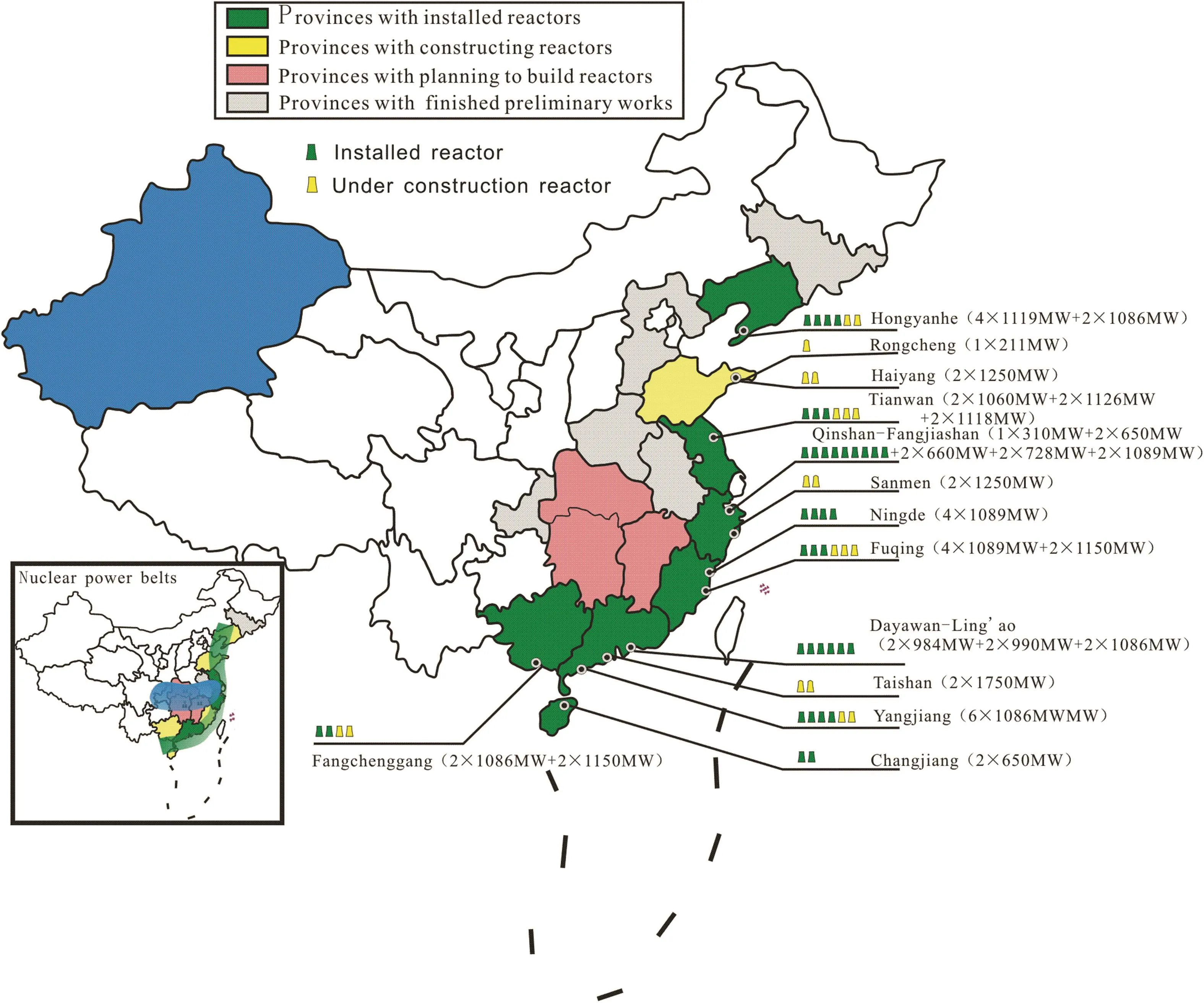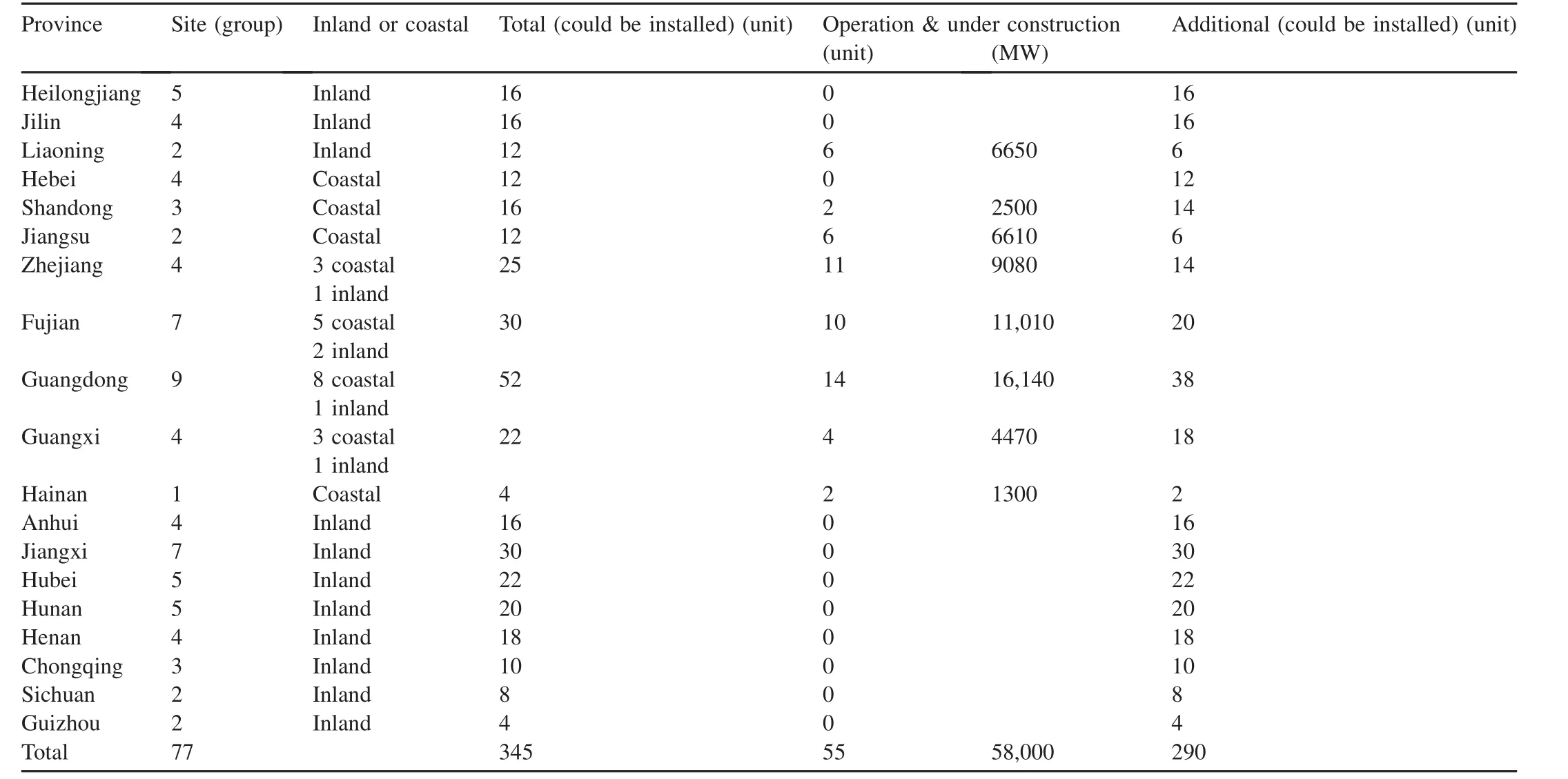China's nuclear power under the global 1.5°Ctarget:Preliminary feasibility study and prospects
XIAO Xin-Jian,JIANG Ke-Jun
Energy Research Institute,National Development and Reform Commission,Beijing 100038,China
Abstract
Keywords:1.5°C target;Nuclear power in China;Solutions;Feasibility;Decision-making
1.Introduction
As concluded in the Paris Agreement,global temperature rise should be controlled below 2°C by 2100.However,it is a world target to further limit it to below 1.5°C,but the measures to achieve the 1.5°C target have not yet been much studied.In recent years,some scholars researched the 1.5°C target and reported simulation results,which indicate that the 1.5°C target requires global carbon emission to get close to zero within 2050-2060 and become negative thereafter(van Vuuren et al.,2016).Based on these conclusions and the carbon emission budget,Jiang et al.(2016,2018)analyzed the major changes needed in the power mix of China by 2050 to realize the 1.5°C target.In this major change trend,China's nuclear power development has a high level expectations(Jiang et al.,2018).This study analyzes the nuclear power capacity needed in China by 2050 to realize the 1.5°C target,as well as the feasibility,necessary measures,and diffi culty.
2.Objectives and requirements for nuclear power in China to realize the global 1.5°C temperature rise target
Power sector plays a very important role in the context of the 1.5°C target.Model analyses show that by 2050,the power generation would have increased to over 14,000 TW h,with per capita 10,320 kW h in China,and 80%of power will be generated with renewable energy sources and nuclear energy(Jiang et al.,2018).Specifi cally,the share of nuclear power,wind power,solar power,hydropower,and biomass energy will reach 28%,21%,16.6%,14%,and 7.6%,respectively,which in 2015 was 3.0%,3.3%,0.7%,17.7%,and 0.3%,respectively.Moreover,theshare of coal power and gas power will reach 5.3%and 7.1%by 2050,respectively,which in 2015 was 71%and 3%,respectively(Jiang et al.,2018).The data show that the power mix will change,which means that powerful policies need to be immediately made to achieve that target.
Furthermore,to achievethistarget,the installed capacity of various power generation modes needs to be signifi cantly changed.The installed capacity of nuclear power plants needs to increase from 26 GW in 2015 to 554 GW in 2050.Considering that the annual uptime of nuclear power plants could increase from 7000 h to more than 7500 h,the installed capacity of China's nuclear power can reach around 500 GW by 2050 to realize the 1.5°C target.
3.Feasibility and obstacles of the nuclear power installed capacity increase to 500 GW
As discussed above,China's nuclear power capacity needs to reach 500 GW by 2050.The feasibility and possible obstacles are discussed below.
3.1.Are site resources for nuclear power plants sufficient in China?
Up to the end of August 2017,37 nuclear reactors have been launched in China,with an installed capacity of 35,820 MW,and 19 nuclear reactorswith an installed capacity of 22,140 MW are under construction,located in coastal Qinshan,Daya Bay-Lingao,Tianwan,Hongyanhe,Ningde,Fuqing,Sanmen,Haiyang,Yangjiang,Taishan,Changjiang,and Fangcheng Port nuclear power bases(Fig.1).
China has abundant site resources for nuclear power.According to three nuclear power enterprises,recent local news media,online public reporting information,and preliminary statistics,the preliminary survey and site selection phases show that nuclear power sites are in the three provinces in Northeast China,coastal provinces in southern and eastern China,Hunan,Hubei,Jiangxi,Anhui,Henan,Sichuan,and Guizhou provinces,as well as Chongqing.
Thenuclear power plantssitesin the provinceswhere plants have been installed are asfollows.In Liaoning,four reactorsat the Hongyanhe site have been launched,while two reactors are being constructed.In addition,six reactors have been installed at the Xudapu site.In Shandong,two reactors are under construction at the Haiyang site,which reserves space for another four reactors.According to the site selection assessment,here are two sites where 12 total reactors can be installed.For the Jiangsu province,two reactors at Tianwan site have been launched,while four reactors are being constructed,and preliminary work has been approved for two reactors,totaling eight,and according to the site selection assessment,four reactors can be installed.Nine reactors have been constructed at the Qinshan Base in Zhejiang province.Two reactors are under construction at the Sanmen site,which reserves space for another four,totaling six reactors,and according to the site selection assessment,there are two sites altogether where 10 reactors can be installed.In Fujian,four reactors have been launched at the Ningde site,which reserves space for another two.Four reactorshave been launched at the Fuqing site,while two are being constructed,and there are fi ve sites where 18 total reactors can be installed.In Guangdong province,six reactors have been launched at the Daya Bay-Ling'ao base and four at the Yangjiang site,while two reactors are being constructed.Two reactors are also under construction at the Taishan site,which reservesspacefor another four reactors,and there are six sites where 34 total reactors can be installed.At Fangcheng Port site in Guangxi province,two reactors have been launched,and two Hualong reactorsarebeing constructed,reserving space for another two.In addition,there are three siteswhere 16 total reactorscan beinstalled.Two reactorshave been launched at Changjiang site in Hainan province,which reserves space for another two.
Nuclear power plants have not being built in Heilongjiang,Jilin,Hebei,Anhui,Jiangxi,Hubei,Hunan,Henan,Chongqing,Sichuan,and Guizhou provinces,but they have many nuclear power plant sites.According to the site selection assessments,thereare45 sitesin the abovementioned provinces,where 172 total reactors can be installed.
Rough statistics show that there are 77 sites in the above provinces,where 345 total reactors can beinstalled.Moreover,56 reactors are already being operated or constructed,with a total installed capacity of 58,000 MW.Therefore,around 290 reactors can be added.Except the two reactors at Changjiang II site in Hainan with an installed capacity of only 650 MW each,the remaining 288 reactors can all feature an installed capacity of 1250 MW(AP100)or 1500 MW each.If 1250 MW per genset is adopted,the total installed capacity of the additional 290 reactors could reach 361.3 GW,making the aggregate installed capacity of all the 345 reactors reach 419.3 GW.If 1500 MW per genset is adopted,the total installed capacity of the additional 290 reactors could reach 433.3 GW,making the aggregate installed capacity of all the 345 reactors reach 491.3 GW,nearly 500 GW.That is,only if the additional nuclear reactors all feature large capacities similar to CAP1400 in the future,and the annual uptime of nuclear power plantsreaches7500 h,can thedemand of 1.5°C target for nuclear power in China be met narrowly.
3.2.How to realize reasonable layout?
At present,installed and under-construction reactors in China are all located at coastal sites.Among the sites mentioned above,31 arealong coasts,where163 total reactors can be installed.If future reactors all feature an installed capacity of 1250 MW each(except the two reactors at Changjiang II site in Hainan with an installed capacity of only 650 MWeach),the coastal total installed capacity would reach 191.8 GW.There are 46 inland sites,where 182 reactors can be installed.If each of them has an installed capacity of 1250 MW,the inland total installed capacity would reach 227.5 GW.Thus,the coastal and inland installed capacities would account for 45.7%and 54.3%of the total capacity,respectively.If future reactors feature an installed capacity of 1500 MW each,the coastal and inland installed capacities would reach 218 GW and 273 GW,respectively.Thus,the coastal and inland installed capacities would account for 44.4%and 55.6%of the total capacity,respectively.
3.3.Does the nuclear power industry have sufficient equipment manufacturing&construction capacitiesand operation&management talents?

Fig.1.Distributing sketch map of installed and under-construction nuclear power plants in China(April 30,2018).It is drawn according to thegeneral position of the city in which the nuclear power station is located.The data come from the annual report and quarterly report of China Nuclear Energy Association(CNEA,2018a,2018b).
The nuclear power plants constructed and launched in the 20th century, such as the Qinshan plant will be decommissioned by 2050.Considering the service life of nuclear reactors,the nuclear power plants built and launched after 2010 and in the new decade can operate till 2050.Preliminary estimation shows that around 10 GW reactors will be decommissioned in China by 2050.Since the construction of nuclear power plants lasts 4-5 years,the construction of the reactorsto belaunched by 2050 must commence prior to 2046.To achieve the nuclear power development targets above,construction of another 290 reactors must begin during 2017(the present)to 2046,at a rate of around 10 reactors per year.This imposes challenges upon the three aspects below.First,can the nuclear power equipment manufacturing capacity meet the demand?At present,China's three major equipment manufacturing bases can output 10-12 reactors every year.Therefore,there will no supply bottleneck in the future.Second,is the nuclear power construction capacity suffi cient?China Nuclear Engineering&Construction Group Corporation Limited once delivered 22 turn-key nuclear reactors in a year.Since construction of nuclear power plants lasts 4-5 years,if the construction of 10 nuclear reactors are started every year,up to 50 reactors will be in the same construction cycle.Therefore,China's nuclear power plant construction capacity needs to be doubled.Third,are there suffi cient operation&management talents?The headcount in 2050 will be 10 times the current size.Undoubtedly,China must staff and train many nuclear power operation&management talents.This is a diffi cult job that requires immediate decisions and expansion of the nuclear science and engineering discipline in colleges and universities.
3.4.Scale of investment and cost effectiveness
The normal construction cost of Gen II advanced reactors in China is around CN¥12,000(kW)-1(Kang et al.,2016).The construction cost of the four Gen IIIAP1000 reactorswill increase because of progressive delay(Zheng et al.,2014).In September 2017,we consulted with Mr.HAO Dong-Qin,a member of the expert committee of National State Nuclear Power Technology Corp.Based on the data provided by Hao,the construction cost of the four Gen IIIAP1000 reactors willreach US$3000(kW)-1or even exceed US$5000(kW)-1.Optimistic estimation indicates that the cost of the AP1000 reactors can be controlled around US$3000(kW)-1in the future because of mass construction,which is less than CN¥20,000(kW)-1.Assuming the all-in cost is CN¥20,000(kW)-1,construction of 361.3 GW(1250 MW per unit)or 433.3 GW(1500 MW per unit)from the present to 2050 will need more than CN¥7.226 trillion or CN¥ 8.666 trillion,respectively.Infl ation and other factors will increase total investment demand to over CN¥15 trillion till 2050,which is at a rate of nearly CN¥500 billion per year.From 2010 to 2016,the annual investment of China's energy industry(including coal,oil,natural gas,and electricity)exceeds CN¥1100 billion,and was a total of over CN¥1540 billion in 2014 and 2015 alone,which is two to three times as much as CN¥500 billion.Therefore,the 2050 total investment demand is feasible.

Table 1 Rough statistics of site resources in China.
China's Gen III nuclear power can get competitive and its cost can near the current benchmark cost of coal power in the eastern coastal regions if the cost is controlled below CN¥20,000(kW)-1because of the mass construction of Gen III plants,proper adjustment of nuclear power policies by the government(such as,delayed provision of spent fuel treatment and decommission charges),and an annual uptime of over 7000 h.However,compared with the reactors currently under operation,those built in the future will become less competitive.Considering the sharp decrease in the cost of renewable power with technological progress,China's nuclear power will be less competitive economically than solar and wind power.
3.5.Uranium resource supply
Acquiring suffi cient uranium resources is an important condition for China's nuclear power development.If the total installed capacity of nuclear power in China reaches around 491.3 GWin 2050,it ispreliminarily estimated that Chinawill need more than 90,000 t natural uranium resources.In 2016,the total global demand was 65,000 t uranium,and the total output is only 62,000 t uranium.Meanwhile,China's natural uranium production of 1600 t only meets quarter of the domestic demand.That is,China's demand for uranium in 2050 would exceed that of thecurrent total global demand,which is far more than the current domestic production in China.Therefore,how to get suffi cient uranium resourcesfor Chinais a great challenge.
According to the resources and reserves estimation of International Atomic Energy Agency(OECDNEA and IAEA,2006)in 2005,the global uranium resources is about 16.2 Mt,which at the contemporary rate can be used for 250 years of global nuclear power consumption.In addition,the world hasabundant unconventional uranium resources,such as phosphate(about 22 Mt)and uranium resources in seawater(over 4 Gt).The potential of uranium resources in China is also very abundant.China's potential uranium reserves are predicted to be 1.7 Mt of uranium.
If China increases its prospecting and exploitation of uranium resources,it can greatly enhance the domestic natural uranium supply capacity.However,considering that the operation period of anuclear power plant is40-60 years,even if China's total potential uranium reserves are exploited and utilized,it will produce only about 200 GW nuclear power.Therefore,if China's nuclear power in 2050 is close to 500 GW,it would require at least 4.25 Mt of uranium reserves,which is beyond the capacity of China;hence,over 60%of natural uranium would have to be imported,which is very difficult.
According to IAEA report(OECDNEA and IAEA,2008),by the end of 2007,among the proven uranium resources in the world,about 2.97 Mt resources cost below US$40(kg U)-1,about 4.456 Mt cost below US$80(kg U)-1,and about 5.469 Mt cost below US$130.Considering that in 2050,nuclear power would also be utilized in other countries,the global nuclear power capacity will be large,and uranium resources that cost less than US$130(kg U)-1may not be enough to meet global demand.Therefore,theprospecting and exploitation of uranium resources that cost more than US$130(kg U)-1will globally become important.This will eventually increase the cost of nuclear fuel.However,because of the cost of fuel is a small share of the total nuclear power cost,the increase of the nuclear power cost will be limited.
3.6.Public acceptance
Large-scale development of China's nuclear power is currently restricted mainly by the concerns about nuclear safety,which is closely related to the current development phase and poor penetration of nuclear power science in China.In the country,government decisions and supports give strong impetus to nuclear power,but the not-in-my-backyard effect and degree of public acceptance have obvious impact on government decisions.
At present,the enhancement of public acceptance is hindered by the following factors.First,there is no strategic consensus on the necessity of massive development of nuclear power and on the role of nuclear power among different provinces,cities,departments,experts,and groups.Especially after the Fukushimanuclear accident,insightsinto theroleand status of nuclear power have been impaired.Second,public knowledge about nuclear safety is not deep enough,making misunderstandings and blind spots rampant in this fi eld.Some experts do not have rational and scientific approach to nuclear safety.Third,nuclear power is not well promoted.Dissemination of nuclear power scienceisnot conducted in largescale and on a national scale,and is given limited attention by the emerging media.Fourth,the necessary mechanisms to safeguard the interests of the public are not in place,which is the largest decisivefactor in differentiating public acceptance.The groups whose interests are safeguarded tend to embrace nuclear power(Xiao et al.,2017).
To enable China's nuclear power meet the demand of the 1.5°Ctarget,public acceptancemust beimproved widely.This requires the following:i)determination in developing nuclear power,reaching consensus,and building scientific decisionmaking mechanisms.Moreover,the awareness of the important role of nuclear power in ensuring energy security,combating global climate change,and eliminating air pollution should bepublicized;ii)strengthening of nuclear power science dissemination,promotion,and education to deepen public knowledge,by methods such as making nuclear power science compulsory in the education system and developing vivid and straightaway ways of promotion;iii)development of a favorable legal system and multi-level interest compensation and mutual benefi t mechanism;and iv)strengthening of information disclosure and public participation to gain wide support.Although,nuclear power enterprises have been embarking on these,it needsto be promoted appropriately.However,obvious achievements have been made in some regions.
4.Conclusions and discussion
A massive development of China's nuclear power is indispensable to achieve the 1.5°C target.This requires nuclear power to account for 28%of the power mix of China by 2050,and a total installed capacity of around 554 GW(assuming annual uptime is7000 h).Considering thepotential increaseof the annual uptime,the total installed capacity should reach 500 GW minimum.
Therefore,in addition to needing supportive policies,China'snuclear reactorsto be built in the future must basically feature large capacities(1500 MW each),and the annual uptime needs to reach 7500 h.Otherwise,supply of the site resources would become intense.
In such context,inland sites will account for around 55%,which requires the immediate construction of inland plants.Supply of nuclear power equipments will not be a bottleneck because of China'sadvantage in thissector,but China'snuclear power construction capacity must be doubled,and training and development of operation&management staff must be immediately commenced.
Massive development of nuclear power demands huge investment in the future,which is not a barrier for China.The major problem isthe cost effectivenessand competitivenessof nuclear power.Because of the increase in the cost of Gen III nuclear power,nuclear power is very likely to be less competitive economically than solar and wind power,but more competitive than carbon power,including coal power and gas power.
If by 2050,around 21%of China's electricity is generated with nuclear energy,nuclear and renewable power will basically account for over 80%in the power mix.In such context,total installed nuclear power capacity only needs to reach around 415 GW,which is easy considering available site resources,nuclear power construction capacity,available funds,and the operation&management talents pool.
Such massive development also needs public acceptance,which in fact already affects the development of China's nuclear power and will have more impact in the future.Therefore,significant improvement of public acceptance has become an important work and must be carried forward across the country.
Acknowledgments
This study was funded by National Key R&D Program of China(2017YFC0404600).
 Advances in Climate Change Research2018年2期
Advances in Climate Change Research2018年2期
- Advances in Climate Change Research的其它文章
- 1.5°C target:Not a hopeless imagination
- Impact of and adaptation strategiesfor sea-level rise on Yangtze River Delta
- Development path of Chinese low-carbon cities based on index evaluation
- Analysis on the synergistic effect of sustainable development of coal industry under 1.5°C scenario
- Changes in temperature extremes over China under 1.5 °C and 2 °C global warming targets
- Changes in surface air temperature over China under the 1.5 and 2.0°C global warming targets
